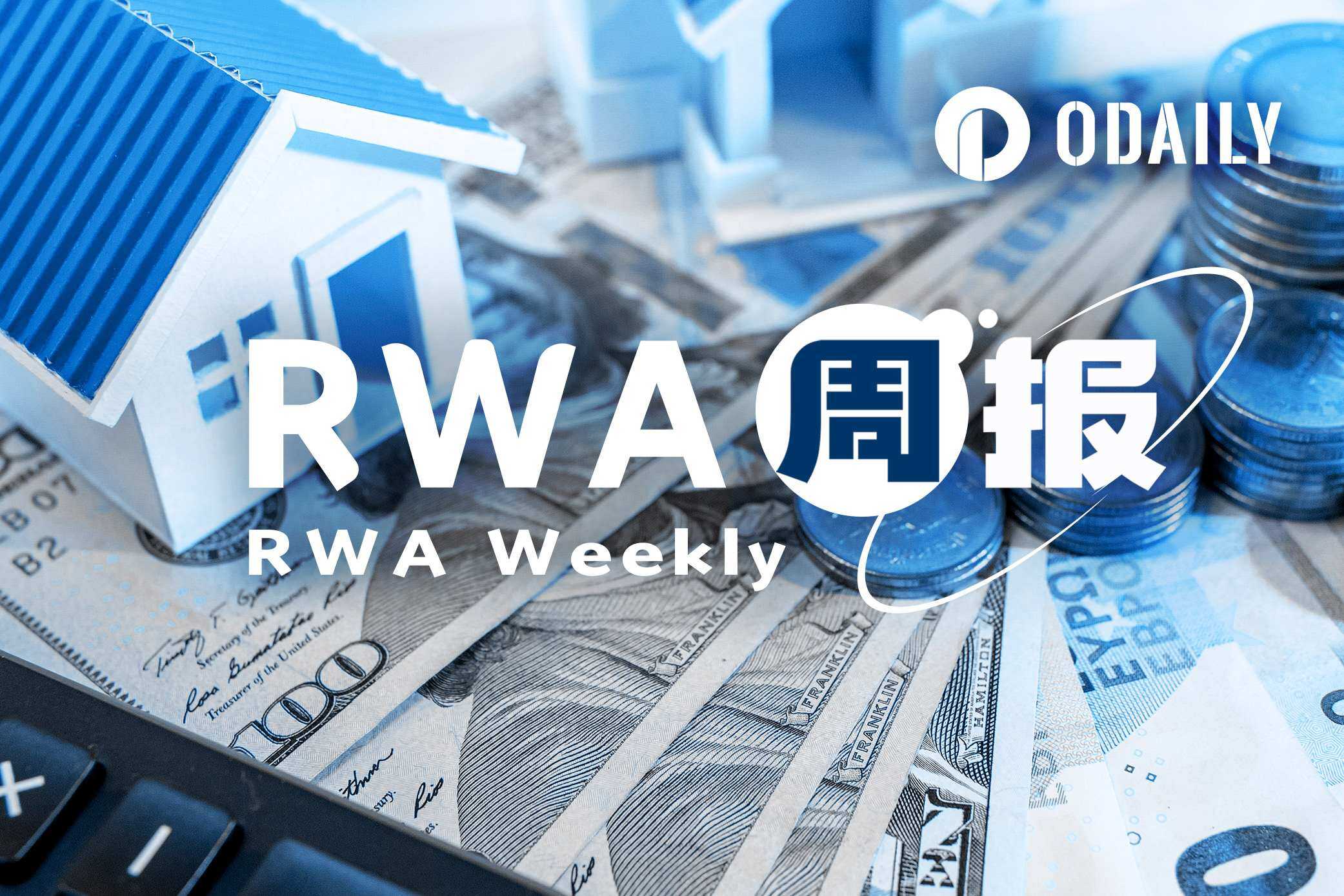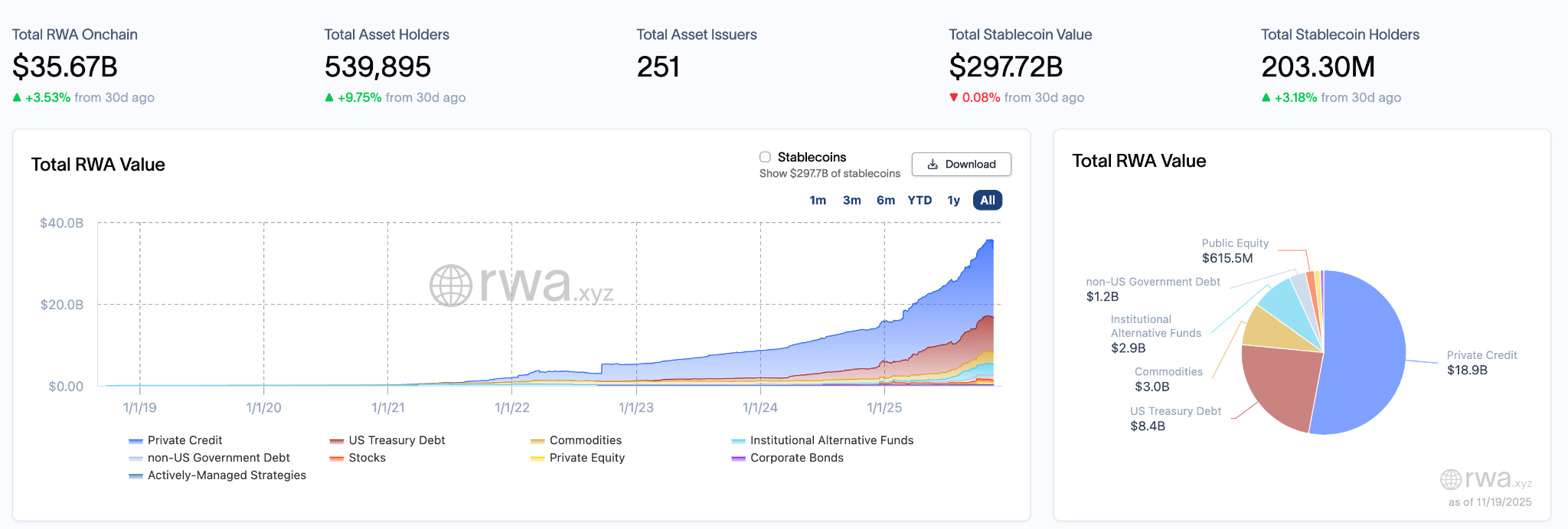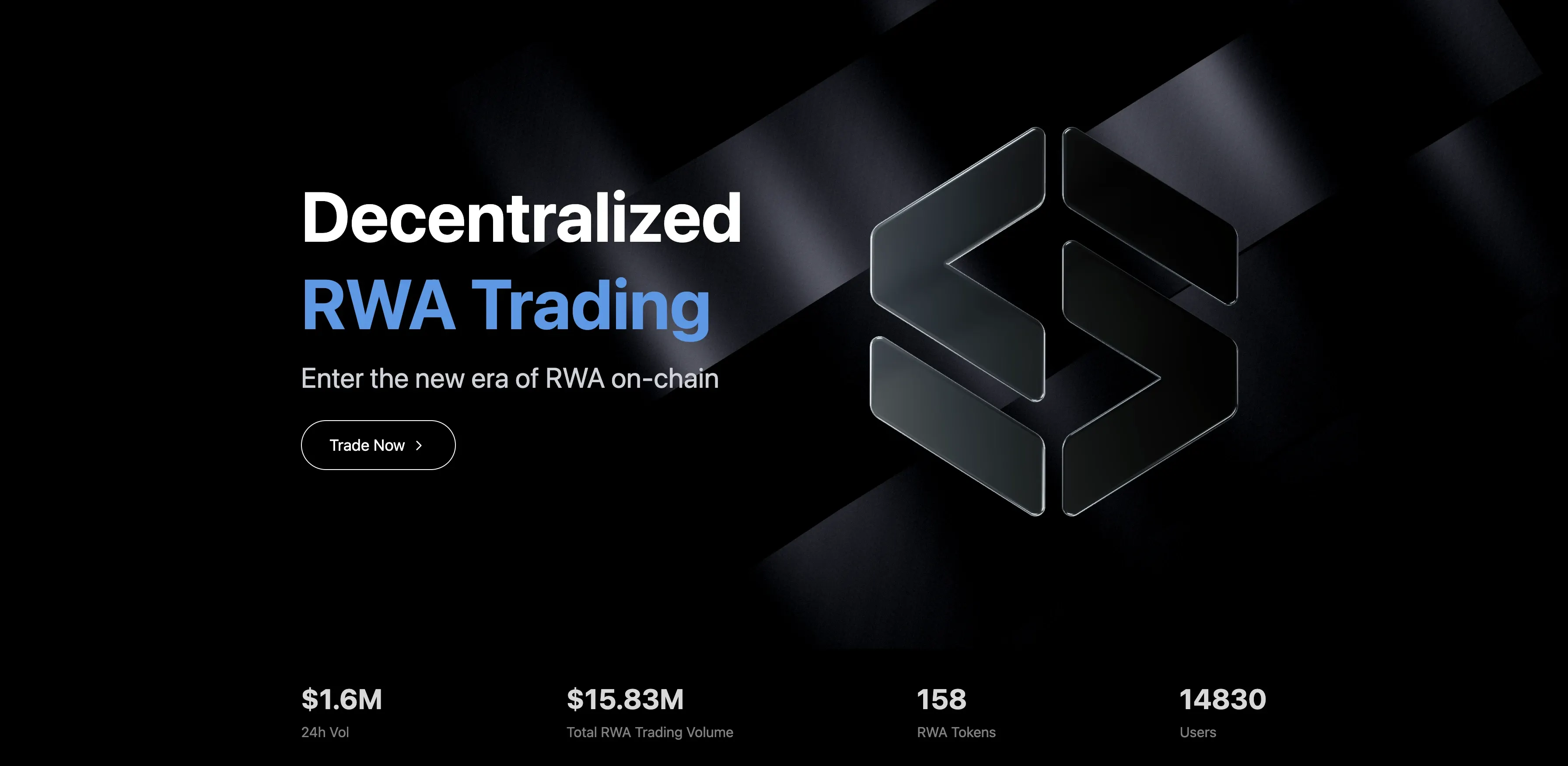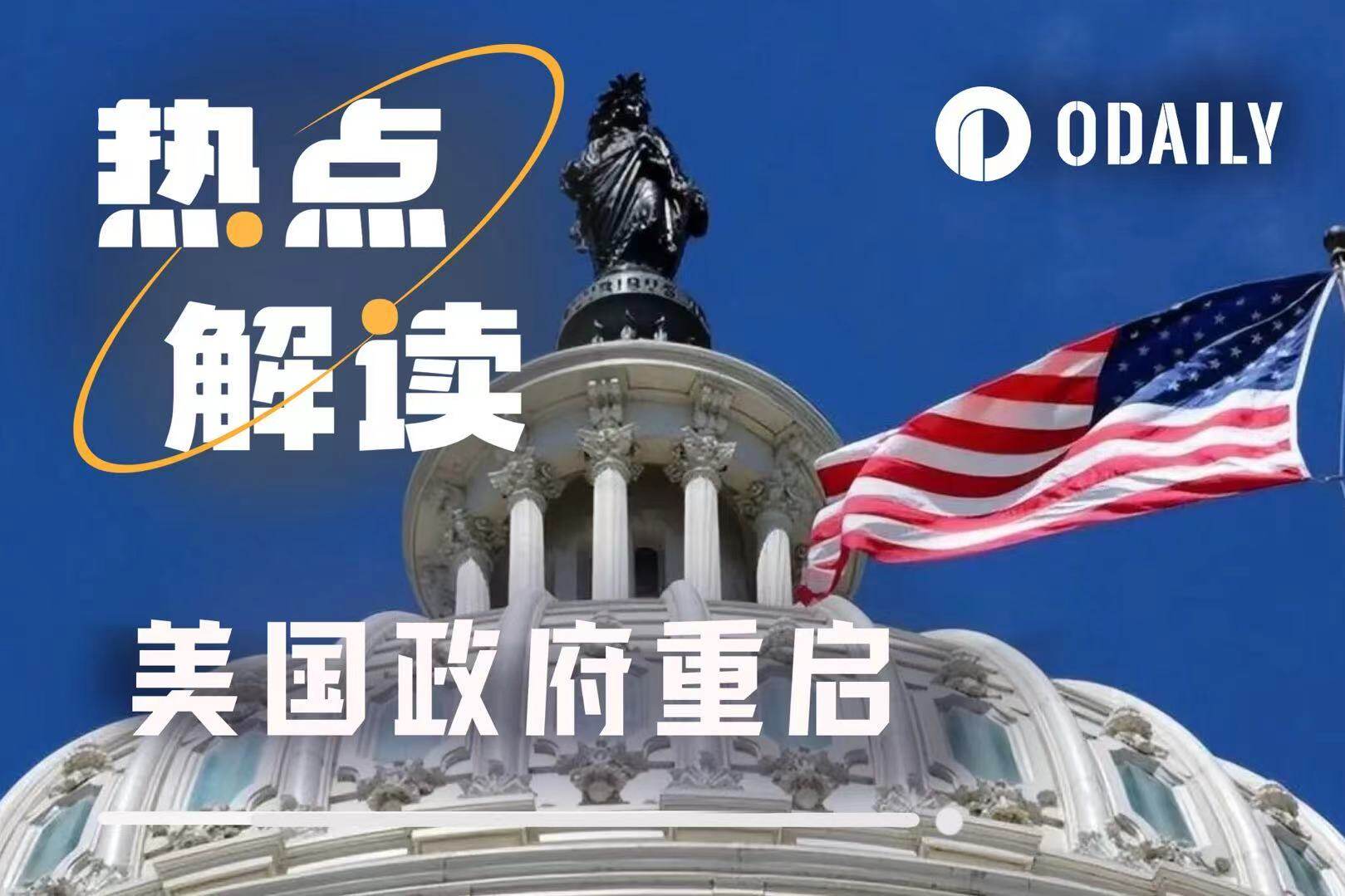RWA Weekly Report | Non-US Government Debt in Assets Rises 20%; US Treasury Secretary Bessenter: Stablecoin Size Could Grow to $3 Trillion by 2030 (November 12-19)
Original article | Odaily Planet Daily ( @OdailyChina )
Author | Ethan ( @ethanzhang_web3 )

RWA sector market performance
As of November 19, 2025, the total on-chain value of RWA was $35.67 billion, a slight decrease of $0.2 billion from $35.69 billion on November 11, a drop of approximately 0.06%. The market as a whole maintained a high-level consolidation pattern, continuing the previous "platform period" trend. The total number of asset holders increased from 534,725 to 539,895, a weekly increase of 5,170, or 0.97%, indicating a gradual slowdown in user growth. The number of asset issuers increased from 249 to 251, with 2 new issuers, and the growth rate also slowed. In the stablecoin market, the total market capitalization decreased from $296.85 billion to $297.72 billion, an increase of $870 million, or 0.29%. The number of stablecoin holders also increased from 201.66 million to 203.3 million, an increase of approximately 1.64 million, or 0.81%, with liquidity improvement slightly stronger than the previous week.
In terms of asset structure, the total value of private credit increased from $18.6 billion to $18.9 billion this period, an increase of $300 million, or 1.61%, returning to a slight growth trend and continuing to maintain its position as the largest single asset class on-chain. US Treasury bonds rose from $8.7 billion to $8.4 billion, a decrease of $300 million, or 3.45%, making it one of the main drags this week. Commodity assets remained unchanged at $3 billion, continuing its sideways trend. Institutional alternative funds slightly declined from $3 billion to $2.9 billion this period, a decrease of approximately $100 million, but remained generally stable. Non-US government debt rose slightly from $1 billion to $1.2 billion, an increase of 20%, making it one of the structural highlights of the week. Public equity decreased from $660.6 million to $615.5 million, a decrease of $45.1 million, or 6.82%, making it the asset class with the largest pullback this week. Other asset classes, such as private equity, corporate bonds, and active management strategies, account for a limited proportion of the overall asset structure and have remained largely unchanged during this period.
Trend Analysis (Compared to last week )
This week, the RWA market maintained a consolidation pattern with minimal overall market capitalization changes, essentially remaining flat. On the user side, both the number of asset holders and stablecoin holders steadily increased, indicating continued user growth, but funds have not yet been largely converted into new asset value. In terms of asset structure, private lending continued to dominate, showing steady growth; US Treasury bonds declined, and publicly traded equity saw a significant correction, indicating minor adjustments in asset allocation; non-US government bonds and commodity assets maintained marginal growth or remained stable, reflecting the continued preference for low-volatility assets. Overall, the RWA market is undergoing a transition from "incremental growth" to "structural optimization," with limited room for further growth, and a zero-sum game becoming the main theme.
Market keywords: consolidation, stabilization, differentiation.

Key Events Review
US Treasury Secretary Bessant: Stablecoins could grow to $3 trillion by 2030
U.S. Treasury Secretary Bessant stated that by 2030, the size of stablecoins could grow from $300 billion to $3 trillion, a tenfold increase.
The Monetary Authority of Singapore (MAS) is developing a regulatory framework for stablecoins, focusing on reserve backing and redemption reliability. It will also test tokenized bank liabilities and regulated stablecoin settlements. DBS Bank, OCBC Bank, and UOB have completed live trials of overnight interbank lending using the Singapore dollar wholesale central bank digital currency (CBDC). The MAS will expand these trials to include tokenized MAS bills settled in CBDC.
The Hong Kong Monetary Authority (HKMA) today announced the launch of EnsembleTX, officially marking the start of the pilot phase of the Ensemble project. This milestone signifies a significant step forward for Hong Kong in conducting real-world transactions using tokenized deposits and digital assets in a controlled pilot environment.
In an exclusive interview, Christopher Hui, Secretary for Financial Services and the Treasury of the Hong Kong Special Administrative Region, systematically elaborated on Hong Kong's strategic layout in financial technology, asset management and commodity markets, aiming to leverage the advantages of "one country, two systems" to create a national "international asset safe deposit box" and serve the strategy of building a financial powerhouse.
Christopher Hui emphasized that the goal of developing FinTech is to "empower the real economy," not to engage in speculation. He cited Tokenization (RWA) as an example, pointing out that Hong Kong is exploring its application in real economy scenarios such as international shipping leasing and corporate fund management, and mentioned that the successful issuance of the SAR government's third batch of digital green bonds is an important step towards normalization.
Hong Kong has passed relevant laws with the goal of issuing stablecoin licenses starting next year. However, the initial number of licenses will be very limited, and regulators will be cautious, clarifying that stablecoins are intended to address pain points in the real economy, such as cross-border payments, rather than being speculative tools.
Hong Kong will push for the transition of the settlement cycle in the Hong Kong stock market from T+2 to T+1, and plans to release a consultation document next year to clarify the timetable. In addition, it will seek to optimize the "dual-class share" system, striking a balance between aligning with international standards and protecting small and medium-sized investors.
Hong Kong plans to increase its gold storage capacity to 2,000 tons within three years and is preparing to launch a central gold clearing system next year. At the same time, Hong Kong is actively promoting cooperation with the Shanghai Gold Exchange to enhance China's pricing influence in the global gold market through a powerful alliance between the two cities.
Hong Kong is actively attracting family offices and plans to submit a bill to the Legislative Council next year to expand tax exemptions to emerging product categories such as digital assets, private credit, and carbon credits, in order to better "catch" global funds.
Tether Holdings SA announced that it has deployed approximately $1.5 billion in credit facilities in the commodity trade finance sector and plans to "significantly expand" this business.
The company stated that it will leverage its nearly $200 billion asset reserves to provide loans in the form of US dollars and its stablecoin USDT, covering commodity trading such as oil, cotton, and wheat. This move is seen as Tether's strategic transformation from a single stablecoin issuer to a comprehensive "digital asset + trade finance" platform, which may further promote the integration of stablecoins with traditional physical assets.
HSBC plans to expand its tokenized deposit service to the US and UAE markets.
According to Bloomberg, HSBC announced plans to begin offering its Tokenized Deposit Service (TDS) to corporate clients in the U.S. and United Arab Emirates (UAE) in the first half of next year, in order to expand its application in the blockchain payments sector.
Service Scope: TDS allows corporate clients to complete local and cross-border fund transfers 24/7 within seconds, significantly improving liquidity management efficiency. The service is available in Hong Kong, Singapore, the UK, and Luxembourg, and supports transactions in Euros, British Pounds, US Dollars, Hong Kong Dollars, and Singapore Dollars.
New Currency: As HSBC expands its business into the Middle East, it will increase its support for the UAE dirhams next year.
Tokenized Deposits vs. Stablecoins: Tokenized deposits are digital notes issued by banks, representing claims on existing deposits, part of the existing banking system, and capable of paying interest. Unlike stablecoins, which are typically issued by non-bank entities and backed by high-quality liquid assets, tokenized deposits are more attractive to corporate clients holding substantial funds due to their adherence to traditional regulatory frameworks.
Future Outlook: HSBC plans to expand the application of tokenized deposits in programmable payments and autonomous funds management systems (leveraging automation and AI to manage cash and liquidity risk). In addition, HSBC is exploring the stablecoin industry and in talks with several issuers to provide reserve management and settlement account services, but has not ruled out the possibility of issuing its own stablecoin or jointly issuing one with other banks in the future.
Bank of New York Mellon launches money market fund designed specifically for stablecoin issuers.
BNY Mellon is launching a money market fund specifically tailored for stablecoin issuers who need to comply with the recently signed U.S. stablecoin laws. The bank's BSRXX is one of the first funds specifically designed for stablecoin providers, aiming to provide them with an investment venue where they can deposit funds received when issuing new tokens, while complying with the GENIUS Act, which Trump signed into law earlier this year. This law requires dollar-backed digital token issuers to invest their reserves in ultra-safe investments with shorter durations than traditional money market funds. Stephanie Pierce, vice president of BNY Mellon Investments, stated that the new fund is designed to meet the law's requirements by holding only securities with maturities of 93 days or less.
Alibaba Group's cross-border e-commerce division is planning to launch an AI-based subscription service and is partnering with JPMorgan Chase to test a "stablecoin-like" payment method to improve the efficiency of cross-border settlements.
The report indicates that this payment tool may be used for international trade and service transactions, aiming to reduce the uncertainty caused by exchange rate fluctuations and shorten settlement time.
Hong Kong-based Bright Smart Securities announced that Ant Group, the offeror for the acquisition, is considering extending the final deadline for the transaction. The deal reportedly requires approval from the Hong Kong Securities and Futures Commission and the National Development and Reform Commission, but it may not be possible to meet all transaction conditions before November 25th. (Caixin)
CZ posted on the X platform, soliciting opinions for his debate with Peter Schiff. One community member pointed out that gold is for those who believe fax machines might make a comeback, a view CZ agreed with, adding that he might use it in his debate with Schiff. Furthermore, regarding the Czech National Bank's (CNB) announcement of a $1 million digital asset pilot portfolio encompassing Bitcoin, USD stablecoins, and tokenized deposits, CZ jokingly commented that "the Czech central bank's digital asset pilot portfolio might need to include BNB."
Yala officially responded to the de-pegging of its stablecoin YU and the liquidity crisis in a post on X.
1. On September 14, 2025, Yala suffered a hacker attack, losing $7.64 million USDC (equivalent to approximately 1,636 ETH at the time). Although this incident caused YU to temporarily de-peg, there were no vulnerabilities in the core protocol. The team injected $5.5 million to maintain stability, and YU was subsequently re-pegged, and the protocol resumed normal operation.
2. On October 29, 2025, Bangkok law enforcement arrested the hacker. Most of the affected funds have been recovered from the hacker and are currently under judicial review. However, due to the fact that some funds were converted into ETH before recovery, the subsequent price drop and the funds already consumed by the attackers have reduced the actual value of the recovered funds.
3. The recent exodus of retail investors from the DeFi market has triggered further panic, putting even more pressure on an already illiquid market. Euler has also been affected as a result, with some of its positions and liquidity previously used to stabilize YU now restricted.
4. Yala is not integrated with Kamino's lending products. The following wallets do not belong to the Yala team or related members:
AyCJS5t4kwRauXShpNygmUqhA2xzwjjVvafNTknNV41X.
5. The team is assessing the amount of funding needed to stabilize the market and is working with law enforcement agencies and funding partners to secure financing. Given the current liquidity crunch across multiple protocols and assets, this process will take time. The team is committed to publishing a clear plan by December 15, 2025, including a funding recovery path and subsequent operational measures.
Trending Projects
Ondo Finance (ONDO)

In short:
Ondo Finance is a decentralized finance protocol focused on the tokenization of structured financial products and real-world assets. Its goal is to provide users with fixed-income products, such as tokenized US Treasury bonds or other financial instruments, through blockchain technology. Ondo Finance allows users to invest in low-risk, highly liquid assets while maintaining decentralized transparency and security. Its token, ONDO, is used for protocol governance and incentive mechanisms, and the platform also supports cross-chain operations to expand its application within the DeFi ecosystem.
Latest news:
On November 19th, Ondo Finance announced on its X platform that it has received EU approval to offer tokenized stocks and ETFs across Europe. This approval expands its reach for tokenized stocks and ETFs to over 500 million investors in the EU and EEA. The underlying prospectus governing the tokenized stock and ETF offerings has been approved by the Liechtenstein Financial Markets Authority (FMA). This move will allow Ondo Finance to offer tokenized stocks and ETFs to retail investors in 30 European markets.
On the same day, Ondo Finance officially stated that since its launch, the trading volume of Ondo tokenized stocks and ETFs has exceeded $1 billion, and its TVL has exceeded $315 million.
MyStonks (STONKS)

In short:
MyStonks is a community-driven DeFi platform focused on tokenizing and trading RWA (Retail Assets and Services) such as US stocks on the blockchain. Through a partnership with Fidelity, the platform enables 1:1 physical custody and token issuance. Users can mint stock tokens like AAPL.M and MSFT.M using stablecoins such as USDC, USDT, and USD1, and trade them 24/7 on the Base blockchain. All trading, minting, and redemption processes are executed by smart contracts, ensuring transparency, security, and auditability. MyStonks aims to bridge the gap between TradeFi and DeFi, providing users with a highly liquid, low-barrier-to-entry on-chain investment gateway to US stocks, building a "Nasdaq for the crypto world."
Latest news:
On November 5th, the MSX platform officially launched its S1 points season and M-Bean incentive mechanism. The platform will statistically analyze real trading and holding activities in US stock spot trading, cryptocurrency futures, and US stock futures, automatically settling the previous day's points at 10:00 AM (UTC+8) daily. M-Beans, a core indicator for measuring user trading activity and contribution, will also be used for the allocation and incentive of the platform's token $MSX. M-Bean calculation considers not only trading volume but also position duration, profit and loss performance, and team Boost level to ensure fair incentives. Team Boost uses a T+2 update mechanism, automatically synchronizing bonuses, and historical trading points are retrospectively incorporated into community incentives.
Previously, MyStonks announced a brand upgrade , officially changing its domain name to msx.com, marking a new era of global fintech. This upgrade not only simplifies access but also reflects a shift from a meme-centric approach to a professional international financial brand, demonstrating its commitment to digital financial innovation and global expansion. The msx.com team stated that it will continue to focus on users, drive technological innovation, and improve the security and efficiency of digital financial services.
Related Links
We've compiled the latest insights and market data for the RWA sector.
What is the main battleground for RWA? What is the underlying business logic of stock tokenization?
In the RWA craze, why is stock tokenization a direction we must pay attention to? For intermediaries, institutions, and individual investors alike, what is the significance of getting involved in the US stock tokenization market? Does buying tokenized stocks equal buying the stocks themselves, and what are the key differences? Where are the compliance boundaries for this type of product? ...
This article details global RWA regulatory practices and representative projects.
What is RWA? A Beginner's Guide to Putting Real-World Assets on the Blockchain
This guide will take you through what RWA is, how it works, its main asset types, and how to explore this emerging field safely and confidently through XT's RWA zone.
- 核心观点:RWA市场进入结构优化阶段。
- 关键要素:
- 链上总价值356.7亿美元横盘。
- 私人信贷增长1.61%占主导。
- 美债与公开股权显著回调。
- 市场影响:存量博弈加剧,资金偏好低波动资产。
- 时效性标注:中期影响。



